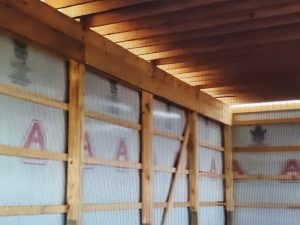Here is the picture – pole building with a 16’ eave height.
(For details on how eave height is defined read: https://www.hansenpolebuildings.com/blog/2012/03/eave_height/)
 Said building has a partial second floor (mezzanine), with the top of the floor at nine feet above grade. Deducting the six inch thickness of the roof system, leaves all of 6’6” of headroom.
Said building has a partial second floor (mezzanine), with the top of the floor at nine feet above grade. Deducting the six inch thickness of the roof system, leaves all of 6’6” of headroom.
The area of this mezzanine just meets the area limitations under the 2012 IBC (International Building Code), Section 505.2.1, “The aggregate area of a mezzanine or mezzanines within a room shall be not greater than one-third of the floor area of that room or space in which they are located. The enclosed portion of a room shall not be included in a determination of the floor area of the room in which the mezzanine is located. In determining the allowable mezzanine area, the area of the mezzanine shall not be included in the floor area of the room.” This particular mezzanine being 16’x36’ of a 36’x48’ building.
So, unless you are my youngest son Brent (who is tall enough to clip the top of his head on the bottom of the trusses at 6’6”) all is good, right?
Well, not quite…. IBC Section 505.2, tells us, “The clear height above and below the mezzanine floor construction shall not be less than seven feet”.
Too many folks think to themselves, “16 foot eave height, I can get two eight foot tall floors in it”. While 8 plus 8 does equal 16, the thicknesses of concrete slabs, the second floor and roof systems have been ignored.
Lowering the requested floor height by six inches can solve the mezzanine height issue above, however this particular client also has ideas of an eight foot tall overhead door opening so his vehicles would be able to enter the door and park beneath the mezzanine area.
Another consideration is what the space will be used for. IBC Table 1607.1 lays out the Minimum Uniformly Distributed Live Loads based upon occupancy or use. For residential use (such as a bonus room), under #25 of the Table) a 40 psf live load would be allowable, however if the area is to be used for storage, then Table #31 would appear to apply, giving a “Light Storage” live load of 125 psf! This poses a significant difference in floor design, thickness and cost.
Probably the best solution for the scenario described above, is to increase the eave height to 18 feet, allowing plenty of clear height both above and below the mezzanine






